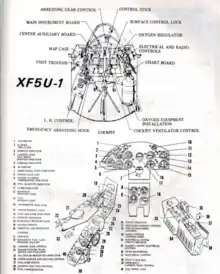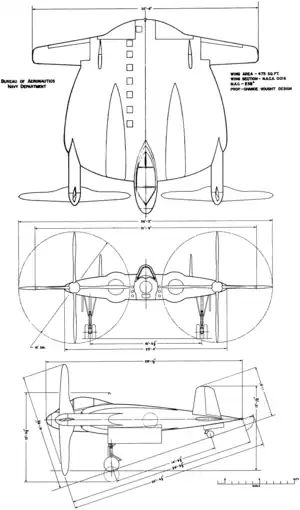Vought XF5U
The Vought XF5U "Flying Flapjack" was an experimental U.S. Navy fighter aircraft designed by Charles H. Zimmerman for Vought during World War II. This unorthodox design consisted of a flat, somewhat disc-shaped body (resembling a flying flapjack/pancake, hence its nickname) serving as the lifting surface.[1] Two piston engines buried in the body drove propellers located on the leading edge, at the wingtips.
| XF5U | |
|---|---|
 | |
| The XF5U-1 during testing | |
| Role | Fighter |
| Manufacturer | Vought |
| Designer | Charles H. Zimmerman |
| First flight | 1943 |
| Status | Cancelled 17 March 1947 |
| Primary user | United States Navy |
| Number built | 2 |
| Developed from | Vought V-173 |
Design and development
A developed version of the original V-173 prototype, the XF5U-1 was a larger aircraft. Of all-metal construction, it was almost five times heavier, with two 1,400 hp (1,193 kW) Pratt & Whitney R-2000 radial engines. The configuration was designed to create a low aspect ratio aircraft with low takeoff and landing speeds but high top speed.[2] The aircraft was designed to keep the low stall speed and high angle of attack from the V-173 prototype while providing for better pilot visibility, cockpit comfort, less vibration, and provisions to install armament. This included a cockpit redesign moving the cockpit from the leading edge of the wing to a nose nacelle that extended further in front of the leading edge. The arrestor hook was changed to a dorsal hook that would diminish the drag from the apparatus.[3]

Normally, a wing with such a low aspect ratio will suffer from very poor performance due to the degree of induced drag created at the wingtips, as the higher pressure air below spills around the wingtip to the lower-pressure region above. In a conventional aircraft, these wingtip vortices carry a lot of energy with them and hence create drag. The usual approach to reducing these vortices is to build a wing with a high aspect ratio, i.e. one that is long and narrow. However, such wings compromise the maneuverability and roll rate of the aircraft, or present a structural challenge in building them stiff enough. The XF5U attempted to overcome the tip vortex problem using the propellers to actively cancel the drag-causing tip vortices.[4] The propellers are arranged to rotate in the opposite direction to the tip vortices, with the aim of retaining the higher-pressure air below the wing. With this source of drag eliminated, the aircraft would fly with a much smaller wing area, and the small wing would yield high maneuverability with greater structural strength.
The propellers envisioned for the completed fighter — unlike the torque-reducing counter-rotating propellers of the V-173 design — were to have a built-in cyclic movement like a helicopter's main rotor, with a very limited ability to shift their center of lift up and down to aid the aircraft in maneuvering. Initially, the aircraft used propellers originally designed for the V-173 prototype.[5] These propellers would be replaced with propellers taken from the Vought F4U-4 Corsair. An ejection seat was fitted to allow the pilot to clear the massive propellers in the event of an in-flight emergency.[2] Although the prototype was unarmed, a combination of six M2 Browning 50-caliber machine guns or four M3 20 mm cannons would be mounted in the wing roots in service.[2]
Testing and evaluation
The XF5U design was promising: specifications given at the time promised great maneuverability and speeds up to 452 mph (727 km/h).[6] However, it came at the time when the United States Navy was switching from propeller driven to jet propelled aircraft. By 1946, the XF5U-1 project was already long over its expected development time, and well over budget.[2] With jet aircraft coming into service, the Navy finally canceled the project on 17 March 1947, and the prototype aircraft (V-173) was transferred to the Smithsonian Museum for display. Although two aircraft were constructed, a lone XF5U-1 underwent ground runs but never overcame vibration problems. Taxi trials at Vought's Connecticut factory culminated in short "hops" that were not true flights.[7][8] The only completed XF5U-1 proved to be so structurally solid that it had to be destroyed with a wrecking ball.[9]
Specifications (XF5U-1)

General characteristics
- Crew: 1 pilot
- Length: 28 ft 7 in (8.73 m)
- Wingspan: 32 ft 6 in (9.91 m)
- Height: 14 ft 9 in (4.50 m)
- Wing area: 475 sq ft (44.2 m2)
- Empty weight: 13,107 lb (5,958 kg)
- Gross weight: 16,722 lb (7,600 kg)
- Max takeoff weight: 18,772 lb (8,533 kg)
- Powerplant: 2 × Pratt & Whitney XR-2000-2 radial engine, 1,350 hp (1,007 kW) each
Performance
- Maximum speed: 452 mph (727 km/h, 393 kn) at 28,000 ft (8,534 m)(estimated)[6]
- Stall speed: 20 mph (32 km/h, 17 kn)
- Range: 710 mi (1,142 km, 620 nmi)
- Service ceiling: 34,500 ft (10,516 m)
- Rate of climb: 3,120 ft/min (15.8 m/s) or 914 m/min
- Wing loading: 39.2 lb/sq ft (191 kg/m2)
Armament
- 6 × .50 (12.7 mm) machine guns
- 2 × 1,000 lb (450 kg) bombs
See also
Related development
Aircraft of comparable role, configuration, and era
Related lists
References
Notes
- Chant 1984, p. 53.
- Winchester Concept Aircraft 2005, p. 247.
- Naval Fighters Number Twenty One Chance Vought V-173 and Xf5U-1 Flying Pancakes. Steve Ginter. 1992. pp. 15, 23.
- Norton 2008, p.165
- Naval Fighters Number Twenty One Chance Vought V-173 and Xf5U-1 Flying Pancakes. Steve Ginter. 1992. p. 15.
- http://www.ibiblio.org/hyperwar/USN/SAC/XF5U-1_FlapjackACP-440601.pdf
- Winchester X-Planes 2005, p. 222. Suggestions of first XF5U flight were confused the V-173 test flying that continued into 1945.
- Jerram 1980, p. 71.
- Jerram 1980, p. 72.
Bibliography
- Chant, Christopher. Fantastic Aircraft. New York: Gallery Books, 1984. ISBN 0-8317-3189-3.
- Ginter, Steve. Chance Vought V-173 and XF5U-1 Flying Pancakes (Naval Fighters Number Twenty-one). Simi Valley, CA: Steve Ginter Publishing, 1992. ISBN 0-942612-21-3.
- Guyton, Boone and Paul Marcus. "The Ups and Downs of The Flying Pancake." True, July 1951. Vol. 29, no. 170.
- Jerram, Michael E. Incredible Flying machines: An Anthology of Eccentric Aircraft. New York: Exeter Books, 1980. ISBN 0-85685-835-8.
- Norton, Bill. U.S. Experimental & Prototype Aircraft Projects: Fighters 1939-1945. North Branch, Minnesota: Specialty Press, 2008, pp. 165–168. ISBN 978-1-58007-109-3.
- XF5U Standard Aircraft Characteristics. Washington, DC: Naval Historical Center at the U.S. Navy Yard. Retrieved: 25 July 2009.
- Winchester, Jim. "Vought XF5U-1". Concept Aircraft: Prototypes, X-Planes and Experimental Aircraft. Kent, UK: Grange Books plc., 2005. ISBN 978-1-84013-809-2.
- Winchester, Jim. "Vought V-173 and XF5U-1 'Flapjack' (1942)". X-Planes and Prototypes. London: Amber Books Ltd., 2005. ISBN 1-904687-40-7.